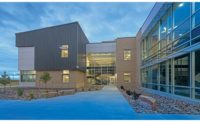Denver’s OZ Architecture is best known for its influential role in helping to create communities that thrive, but its portfolio encompasses a breadth of work that is driven by the passion of individual designers.
“Our niche is really unusual,” says Becky Stone, one of the firm’s 21 principals. “We are a generalist firm, and because we have a series of partners who all have their own niche, it’s more like a collaboration of partners who each attack a different segment of the market.”
The firm’s diverse portfolio includes designs for resort villages and dynamic cityscapes across the country, and master plans for the city of Kigali in Rwanda and the southern tip of Antarctica—where OZ is reshaping McMurdo Station for the scientists who study climate change there.
As the hot markets have shifted, so has OZ. “Today we’re seeing mixed-use and residential; the late ’90s was corporate and office; and the 2000s was resort and hospitality work,” says OZ principal Kelly Davis. “As we’ve seen those markets grow, our broad portfolio and breadth of experience has allowed us to move with them, a strategy for OZ since it has been in existence.”
Urban Design
When OZ designed the Waterside Lofts on Denver’s Speer Boulevard in the late ’90s, the urban-living complex was the first of the large, new condo projects to take shape in downtown Denver at the time. Today, OZ is tackling the ambitious 250 Columbine project in Denver’s Cherry Creek North (CCN) neighborhood, a redevelopment that incorporates office, retail and residential components. It encompasses an entire city block, replacing 1970s architecture and setting a design standard for the trendy neighborhood.
OZ worked with the city and the community to create new zoning for the Cherry Creek business district. It provided computer modeling to illustrate how different scenarios might affect Cherry Creek North. 250 Columbine was the first project to be developed under the new zoning.
“Columbine was a very complicated project due to its three different uses, and the entire block phase,” says Julie Underdahl, president and CEO of the Cherry Creek North Business Improvement District. “OZ had to apply the new zoning to this concept and make it work—and now it’s a prototype for what the entire CCN district is becoming—more of an urban mixed-use district.” OZ worked with the business district to address neighborhood concerns. The result is a project that varies from eight stories at the commercial end of the block to four stories on the residential side, while combining both offices and condos—a rarity in both Cherry Creek and Denver.
The landscape of Denver’s River North neighborhood—RiNo—is changing daily, with OZ at the helm. The relocated World Trade Center, hotels, office and residential high-rises are all being carefully designed into a dense urban redevelopment formerly occupied by warehouses and seasonal stock show traffic.
“We’re involved at some level in every square inch of RiNo being redeveloped,” says Davis. “This is a huge pocket of growth for downtown Denver—a whole neighborhood bigger than LoDo or the Highlands. Having our office here and being embedded in the hip, growing, exciting part of Denver has been great.”
Team-Based Culture
Founded in 1965, the name OZ comes from the initials of two of the firm’s founding principals, Tom Obermeier and Alan Zeigel. The name was a purposeful decision on their part to ensure it would outlast their time with the firm, allowing following generations to carry on a seamless tradition. “Even that element is part of the entrepreneurial piece of the firm,” Stone says.
OZ has designed more than 100 hospitality and resort projects—from those in mountain and beach towns across the U.S. to projects in China and Bolivia. The firm has been the master architect for Colorado’s Snowmass Base Village for 20 years, creating one of the largest fully planned core communities in the state. The high-end ski resort town just outside Aspen is currently incorporating a plaza area with an ice rink and fountain, the Limelight Hotel and three residential units.
“They collaborate really well; they’re able to work directly with our day-to-day operators as well as the development arm,” says Don Schuster, vice president of hospitality, Aspen Skiing Co. He has worked with OZ on overall design and infrastructure since early 2000. “We’ve involved our hotel management group in the [design] process, and OZ understands their unique needs. They are able to incorporate the architectural intent of the building with the concept that interior design brings to the project.”
While OZ’s team-based culture is not unique to big design firms, its familial atmosphere encourages collaboration throughout the company among all employees and levels.
“Our culture is unique: no closed offices, and we don’t concentrate on titles,” Stone says, adding that it’s normal to see kids and dogs running around the office at any given time. “We’re family. It’s a place where you bring your outside life into the office environment; we embrace that.”
Stone notes that 65 of the firm’s 150 employees are female—a higher percentage than is typical in most architecture firms, even today, she says. “That’s likely why our culture incorporates a casual approach, bringing your home life in. This culturally changes the firm a bit,” she says.
With a wellness committee, rock climbing and running clubs, even a kickball team, “we work hard while at work and also play together—and that’s pretty unusual,” she says.
Younger staff work on their individual passions and grow with the firm while being mentored by more senior members; as a result, people tend to stay at OZ for a long time, Stone adds.
“My team sits at a 40-ft table with 10 people on a side,” says Davis. “We have conversations, we bond, and the awareness of who’s doing what on a project increases immensely.”
OZ has inverted the typical office layout—instead of having folks clustering in cubicles facing corners and staring at computer monitors, everyone faces their teammates. Davis sits across from a recent graduate, and he says that even something as simple as changing the physical office layout creates an environment where everyone is an equal part of a team.
Davis, who has experience working in and with other design firms, says OZ does more than any company he’s seen to nurture and give opportunities to the firm’s younger generation. “That’s our core philosophy: to give them skills and the ability to grow and become leaders.”
“I’m young, by architect standards,” he adds. “But I’m in the background supporting those on my team and allowing them leadership positions and coaching them to be successful. That’s the future of our company—what we can pull out of all of our tremendously talented staff.”
“I’ve never used an architectural firm on as many projects as I have OZ,” says Robert Thompson, CEO and founder of Punch Bowl Social, a Denver-based dining and entertainment venue that is rolling out its brand to 20 locations across the nation. Punch Bowl has opened six locations so far and is actively working on 11 more across the country.
“I’ve found a legitimate collaboration partner, and they’ve become an extension of me. OZ has been able to metabolize my brand and produce a product that has been consistent while appropriately evolutionary,” he says. Initially drawn to OZ because he needed a creative firm, Thompson was struck by its capacity to keep up with his company’s growth. “This is very different from doing 11 Chipotles,” he says.
Davis says OZ is doing “more and better work” with a staff of 150 than when the firm had 230 people just six years ago.
“It’s a testament to our ability to attract and retain the best and brightest, and becoming smarter as a company in how we deliver work,” Davis says. “That’s our strategy going forward: attract the best and the brightest and be efficient with our tools.”









Post a comment to this article
Report Abusive Comment